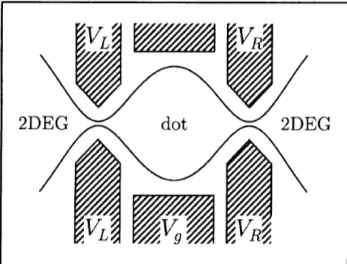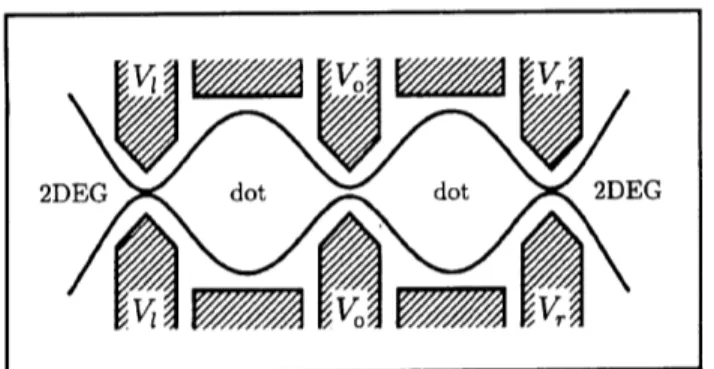Chapter 3. Coulomb Blockade In Single And Double Quantum Dots
Chapter 3. Coulomb Blockade
In
Single And Double Quantum
Dots
Academic and Research Staff
Professor Patrick A. Lee, Dr. Akira Furusaki, Dr. Konstantin Matveev
Technical and Support Staff
Margaret O'Meara
3.1 Project Description
Sponsor
Joint Services Electronics Program Grant DAAH04-95-1-0038
A few years ago, Professor Kastner's research group discovered that the conductance through a quantum dot weakly coupled to the leads shows periodic peaks as a function of the voltage on a gate electrode.1 This behavior was attributed to the phenomenon of Coulomb blockade: to add an elec-tron to the dot, the system must have an energy equal to the electrostatic energy of a dot charged by one electron. Most of the theoretical and exper-imental work on Coulomb blockade is devoted to the case when the quantum dot is separated from the leads by very high tunnel barriers, which ensure the discreteness of charge in the dot. A recent experiment2 indicates that as the height of the bar-riers is lowered, the Coulomb blockade peaks are smeared and transformed into small oscillations. Apparently, as one lowers the barriers between the dot and the leads, the discreteness of the charge of the dot is smeared, and the Coulomb blockade is suppressed. An important theoretical problem is to find the conditions at which a dot strongly coupled to the reservoirs can exhibit the Coulomb blockade. Our preliminary studies3 showed that a quantum dot connected to a lead by a single contact should demonstrate the Coulomb blockade oscillations of the dot's charge as long as the transmission coeffi-cient of the contact T is less than unity. Exper-imentally, it is difficult to measure charge and in the
past year our research group worked on the theory of the transport through quantum dots.
3.2 Transport Through a Single
Quantum Dot
The system we study is shown in figure 1.4 The quantum dot is coupled to the reservoirs (leads) by two quantum point contacts controlled by the corre-sponding gate voltages. Inside the electrostatically created constrictions, the potential changes adiabatically as the electrons move along the channel, which enables us to describe the transport by a one-dimensional model. We study the linear conductance through the quantum dot as a function of the gate voltage in the regime where the trans-mission through one or both contacts is almost perfect: the transmission coefficient T is close to 1. The results are as follows:
1. In agreement with the experiments, we found that the Coulomb blockade oscillations of the conductance disappear when the transmission through at least one contact is perfect, T=1. If
neither of the contacts is in the regime of perfect transmission, the conductance shows weak periodic oscillations as a function of the gate voltage.
2. An unexpected result was obtained: unlike the oscillations of the average charge of the dot, the amplitude of the oscillations of conductance grows as the temperature is decreased (figure 2). At very low temperatures, the oscillations are no longer weak, and to find the
conduc-1 M.A. Kastner, Rev. Mod. Phys. 64: 849 (conduc-1992). 2 N. C. van der Vaart et al., Physica 189B: 99 (1993).
3 K.A. Matveev, Phys. Rev. B 51: 1743 (1995).
Chapter 3. Coulomb Blockade In Single And Double Quantum Dots
Figure 1. Schematic view of a quantum dot connected
to two bulk 2D electrodes. The dot is formed by applying negative voltage to the gates (shaded). Solid line shows the boundary of the 2D electron gas (2DEG). Electro-static conditions in the dot are controlled by the voltage applied to the central gates. Voltage VL,R applied to the auxiliary gates controls the transmission probability through the left and right constrictions.
tance a non-perturbative solution is required. Such a solution was found for several cases, and we discovered that in the low-temperature regime the weak oscillations of conductance are transformed into sharp peaks.
3. The conductance in the centers of the peaks is of the order of the conductance quantum e2/h if the barriers are identical, and proportional to the temperature in the asymmetric case. Between the peaks, the conductance is always proportional to the square of the temperature. Our theoretical description of the problem is appli-cable in a wide range of temperatures between the charging energy of the dot and the quantum level spacing. We believe that the results can be easily tested in the experiments.
3.3 Transport Through Double
Quantum Dots
In a recent experiment,5 the Coulomb blockade
oscillations of conductance through a system of two quantum dots (figure 3) were studied.6 In the
exper-iment the contacts between the quantum dots and the leads were in the weak tunneling regime, with transmission coefficients T,r < 1. On the other
Figure 2. Conductance through a quantum dot as a
function of the dimensionless gate voltage N for the case when the transmission coefficients for both contacts are 0.96. The dashed line represents the conductance in the high-temperature limit. The curves a) and b) are for the temperature equal to 0.04 and 0.005 in units the charging energy.
hand, the contact between the dots was tuned by adjusting the gate voltage Vo in such a way that the corresponding transmission coefficient To scanned the whole region from 0 to 1. As a result, a series of the dependences of the conductance on the gate voltage at different values of To were measured. The experiment showed that as the transmission through the constriction between the dots is increased, the periodic peaks in the conductance split into doublets. The distance between the com-ponents of the doublets grows with To, and at To = 1 the periodicity is restored, but with a period which is smaller by a factor of two.
Some features of the experiment are easily explained on the basis of conventional theories of the Coulomb blockade. For instance, the change of the period by the factor of 2 is due to the fact that when the two dots a strongly coupled, they form a large single dot with a doubled capacitance. On the other hand, the splitting of the peaks when the transmission coefficient To is between 0 and 1 cannot be explained with the usual electrostatic approach. The goal of this project is to develop a quantum theory of transport through the double dot system.
5 F.R. Waugh et al., Phys. Rev. Lett. 75: 705 (1995).
6 K.A. Matveev, L.I. Glazman, and H.U. Baranger, Phys. Rev. B 53: 1034 (1996).
Chapter 3. Coulomb Blockade In Single And Double Quantum Dots
Figure 3. Schematic view of the double quantum dot system. The dots are formed by applying negative voltage to the gates (shaded); the solid line shows the boundary of the 2D electron gas (2DEG). V, and V, create tunnel barriers between the dots and the leads while Vo controls the transmission coefficient through the constriction connecting the dots.
We start with the theory of the positions of the peaks in conductance as a function of the gate voltage. When the tunneling between the quantum dots is weak, an electron added to the double dot system can occupy two energetically equivalent positions on either the left or right dot. As a result, there is a double degeneracy of the peak positions. As the barrier between the two dots becomes more transparent, the degeneracy of the two states is
lifted due to the hybridization of the two quantum states. Thus, the splitting of the peaks at To > 0 is proportional to the decrease of the ground state energy of the double dot system due to the quantum fluctuations of the charge between the dots. We have been able to find the peak splitting in the both limiting cases of the transmission coeffi-cient To close to 0 and 1. At small To, the splitting of the peaks is linear in To; at To near 1, the devi-ation of the peak positions from the equidistant positions is proportional to (1 - To) In(1 - To). The results are summarized and compared with the experiment in figure 4.
We have also investigated the temperature depend-ence of the peak heights. In the conventional theo-ries of the Coulomb blockade, the heights of the peaks in conductance are temperature-independent. This result applies to the double-dot system in the regime of very weak coupling between the dots. However, as the coupling between the dots becomes stronger, the peaks acquire a power-law temperature dependence. The origin of this temperature dependence is similar to
1.0 p 0.8 S0.6 = 0.4 E
o
0.2 0.0 0.0 0.2 0.4 0.6 0.8 1.0 Go/(2e2 /h)Figure 4. The normalized splitting blockade peaks as a function of the tance. Our theoretical results (dashed
of the Coulomb inter-dot conduc-lines) are in good
agreement with the experiment (crosses and pluses). The splitting is normalized by the period of the peaks in the strong tunneling limit.
the well known "orthogonality catastrophe." When an electron tunnels from the left lead into the left dot, the right dot is also affected: to achieve the lowest possible energy, one-half of the charge of the added electron must be transferred to the right dot. Thus, the system must significantly modify its ground state in order to accommodate an additional electron. This effect shows up as a power-law sup-pression of the tunneling rates at low temperatures. In the case of nearly symmetric dots, we found that the conductance peaks are suppressed as power 5/4 of the temperature. We expect that this result can be easily tested in our experiments.
3.4 Publications
Furusaki, A., and K.A. Matveev. "Coulomb Blockade Oscillations of Conductance in the Regime of Strong Tunneling." Phys. Rev. Lett. 75: 709 (1995).
Furusaki, A., and K.A. Matveev. "Theory of Strong Inelastic Cotunneling." Phys. Rev. B 52: 16676 (1995).
Matveev, K.A., L.I. Glazman, and H.U. Baranger. "Tunneling Spectroscopy of Quantum Charge Fluctuations in the Coulomb Blockade." Phys.
-
full C matrix
full
C
matrix
--
N. N. approx.
1
010-2
L Uk'o-4
,, 4---. ",
,",,
.
, ,
i ,h
"/.
"
I I'10-6
/10-
r
k'
IL
,%
L
1 U
-6
io
I
:I I 'IV,
5
7
..,
"Soliton" potential distribution in a 1 lx11 2D quantum-dot (solid line mesh) and the nearest neighbor approximation center of the array (x = y = 0). (see section 4.6)
array, computed using the full capacitance matrix
(dashed line mesh). The soliton is located at the
58 RLE Progress Report Number 138

